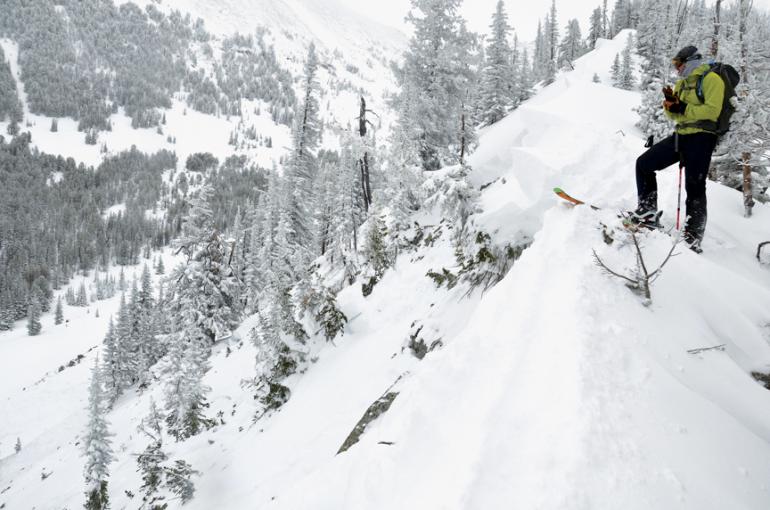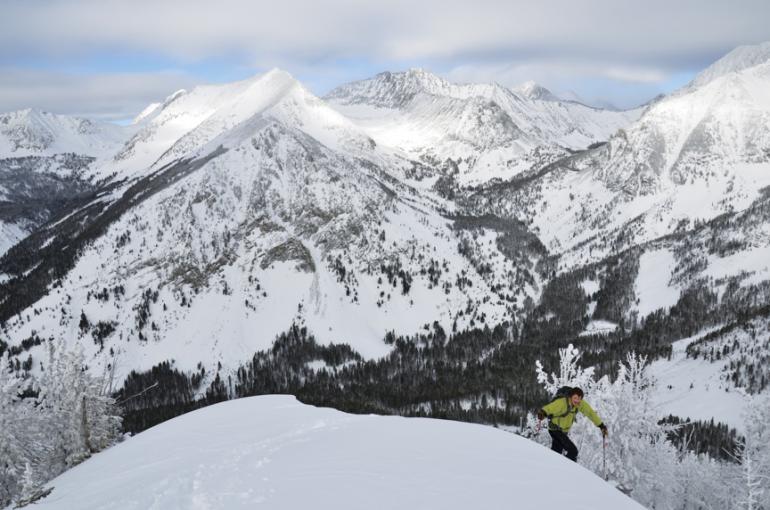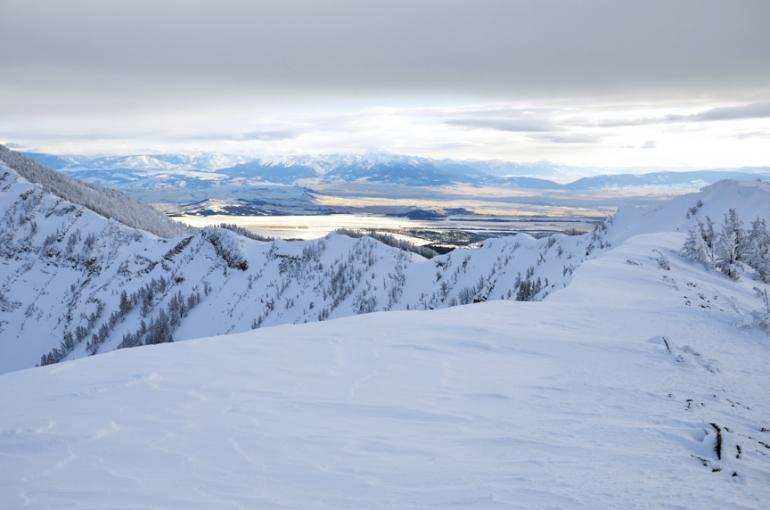Gettin' Crazy
A wild trip in the Crazies.
With soaring peaks that remain snow-capped much of the year, the Crazy Mountains have drawn me like a moth to flame since I arrived in southwest Montana six years ago. So when my friend Bob said he’d like to do a ski trip in the Crazies, I jumped on board. Our plan was simple: snowmobile to a Forest Service cabin and spend three days skiing the heart of this island range. It all seemed easy enough—drive in, ski, eat, sleep, repeat.
I had no idea what I was getting into.
Unpromising Pre-Game
Bob’s just getting off a 24-hour shift and I’m missing most of the skin from the soles of my feet (don’t ask). Weary and war-torn, we embark at dusk. About 20 minutes outside of town, we drive straight into a blizzard—crawling along Highway 191 in the dark and making horrible time. An hour later, I realize I forgot the plastic ice-fishing sled we were going to use to tow gear. We’ll have to figure something else out.
Rolling into Harlowton, we make a beeline for Midtown Market, walking out with a plastic storage box as our new “trailer.” I could only imagine the sight we would make, towing this thing behind us… it turned out to be every bit as redneck as I had envisioned it.
We reach the junction with Highway 89, and it’s decision time: hotel up in White Sulphur Springs or press on to the cabin? It’s late, it’s snowing and blowing, neither of us knows the way, Bob is approaching 30 hours without sleep, and we won’t reach the cabin until about 2am. The choice is obvious… we go for it.
Immediately, I begin poking holes in the thing and rig it with tie-downs while my sleep-deprived associate weaves the pickup around snowdrifts and into the storm. All Bob has to do is make each of the unmarked 90-degree bends in the road. Easy.
We get to the parking area, launch the Ski-Doo out of the truck, and get to work. Food, water, gear: check, check, and check. thing linkage: check. We ease our way out of the parking lot. I’m seated on the very rear of the snowmobile, aft-facing to monitor the thing. Bob is still awake and driving. All is well. Bob throttles up ever so slightly. Again, all is well. I begin to relax. Bob begins to relax.
What happens next defies physics.
The thing explodes. It doesn’t just crack in a few places—it splinters apart like a lightning-struck tree.
We’ll have to make two trips. We stash gear, collect debris, re-fit the snowmobile, and get going. The drone of the snowmobile lulls me to sleep. I wake up. We’re stuck. My leg is trapped and I struggle just to get off the machine. This is just the first of many extrications we will perform over the next three days.
Rolling in at 1:22, we arrive at the cabin ahead of schedule. Bob departs to retrieve our stashed gear while I get the cabin in order and cook a meal. Bob gets back and we eat. What do you call a meal at 2am? It’s warm and it’s calories—beyond that, we don’t care. Half an hour later, the lights are out, alarms OFF. We won’t be rising with the sun.
Opening Day
Since it’s too late to do much else, today will be a scouting day. I’m relegated to skijoring behind the machine for most of the trip—this means that I get good at taking ice chunks to the teeth.
En route, we get stuck. Not stuck like the night before—that was foreplay. We get stuck in a way that only the dinosaurs of La Brea Tar Pits would understand. We finally reach our destination as my stomach begins to eat itself.
We stop to enjoy a bagel. In the time it takes to masticate the dense, chewy bread, a Class IV hurricane colonizes central Montana. Powerful gusts threaten to delaminate skin from muscle. Undaunted, we hunch into the wind and slog upward through the timber. Venturing into a clearing, I uncurl my torso and stand erect, fulfilling my evolutionary destiny. I pay for this mistake as gale-driven ice pellets blast my face like I’m bird hunting with Dick Cheney. Unable to see anything, we beat a hasty retreat back to the Ski-Doo.
On the way down, I poke around in the snow. It’s a mixed bag with plenty of shear planes. Driving to home base, we discover that the breeze has dumped a few dozen trees across the track. We hack our way out of the wilderness with a pruning saw—nothing is easy here.
Back at the cabin, we team up to unpack the sled, shovel snow, haul firewood, and split a fresh pile. As dusk approaches, I retire to the maw of the cabin to prepare our dinner. Around 8pm, Bob falls asleep with his headlamp on. Sipping a good single malt, I reflect on life. Everything might be harder out here, but it’s also simpler. We climb, ski, dig, haul, chop, and eat. It’s a good life—one that makes a man sleep well. And makes him supremely grateful for the warm, dry cabin and the hot food in his belly. I go out on the porch and raise my glass to the blackness beyond the glow of the cabin... to all the wild critters who are now on the edge of winter’s blade, I salute you.
Getting into Gear
Day 2 is significantly colder outside. The wind isn’t as bad… yet. We try another shortcut and somehow get lost—out in the open. By the grace of Garmin, we get to our starting point for our daily bagel repast. The wind picks up again. We launch straight up the gut of the drainage. The ridgeline off my right shoulder leads to a major peak and there are beautiful lines of powder diving off it the whole way. Believing the risks can be mitigated, we decide to stay in the gut.
A few hundred yards later, I abruptly turn straight uphill, setting tight switchbacks between the densest clumps of trees I can find. I am not sure why I do this. There is no whumpfing, cracking, or fresh avalanches. But that decision may just save our lives.
We punch through squalling snow to gain the ridge. Paralleling the cornice line, I trigger a small slide in the new snow. It makes a muffled swishing sound—a covert killer, not the quintessential roaring crescendo. Just a few yards beyond that slide, we trigger a collapse—the audible whumpf raises the hair on the back of my neck. I’m on high alert now. Too many signs are adding up.
But I’m also excited to get an avalanche on camera. We find a suitable overhang and I set up. Before Bob can deliver the coup de grace, the overhang fractures on its own, crashing onto the slope below. The impact triggers a massive avalanche. Unfortunately, the cornice line breaks farther back than expected, and a tragic comedy plays out on me.
The block I’m standing on breaks off and starts to slide downhill. I jump off and land headfirst in a tree well, skis attached and uphill, camera hopelessly buried in soft snow. The second biggest avalanche I’ve ever witnessed in the backcountry is living out all its glory not 30 feet from me and I can’t see or do anything! Bob frowns and says, “I can’t believe you didn’t get that.”
We need a way out, so we do what any sensible person would do in this situation: go higher. The ridgeline degenerates into voodoo-like rock outcrops and spires. After searching for more than an hour, we find an exit. We name the spine “Goblin Ridge,” and our exit saddle “Rolaids.”
On our way down through the debris, I see our skin track just 20 yards from the lower flank of the slide. If we had continued up the gut, we may have triggered the avalanche from below and been fully buried in the terrain trap of the creek bottom. Nevertheless, we enjoy some great turns on our way back to the snowmobile. When we get there, the road is freshly groomed, the clouds are breaking, and glowing light illuminates the western sky.
Bob asks me, “What would you have done if it didn’t slide?” He hits the nail on the head with that question. I pause for a moment.
“I don’t know,” I admit. We head for home, glad to enjoy a peaceful evening.
By now, Bob and I fall into chore mode effortlessly, and everything gets done without needing to speak. Tomorrow is our last day and we want to make the most of it. We decide to shoot for high cirque we spotted from Goblin Ridge. It’s got safe routes up and down and it looks like a real tour.
Our work done, we settle into the comfort of the cabin. I feel a deep relaxation that comes only after a hard day has turned out well. I am content, absorbing the radiant heat of the woodstove, jotting down my notes. Bob is laid out on his bunk, smoking a cigar.
Bob starts talking slowly, deliberately. “It was a good day. Probably one of the most adventurous backcountry days I’ve had. But ya know, it feels like we’re still in the experimental phase. I’d like to have this place dialed. To be able to calculate where to ski and how, depending on conditions.”
He’s chomping at the bit. He wants to get into ski mountaineering and these half-day ski tours in marginal conditions aren’t exactly floating his boat. I understand that.
“I think you being here is hindering me.” It’s brutally honest, and not intended to be an insult. What he means is that he needs to be on his own, to make his own decisions. And that’s hard with me here, acting like a guide and teacher. I vow to let him lead tomorrow.
Then he laughs and says, “Of course it’s a love/hate relationship. On one hand, I was up there today thinking, ‘What am I doing here?’ ‘cause I was freaked out. But now, back at the cabin, I love it, I want more of it.”
Forbidding Finale
We’re at our new parking spot by 12:30 for our customary bagel and are hiking by 12:45. Bob is leading and he chooses good routes all the way to the bottom of the cirque where we swap. The sun is shining, winds are calm, and temps are crisp. It is a perfect day—until I lead us into horribly steep, craggy terrain with rotten, faceted snow that we can’t skin up. We remove our skis and start bear crawling. It’s easier for me because of a thin windslab on top. I break it up though, and there is nothing but ball bearings for Bob to follow on. Finally, it feels like mountaineering.
We haul ourselves to the top of a knob, gaining the ridge and its breathtaking views. From here, we can clearly see the whole route before us, including the line we intend to ski. I take lots of mental notes and suggest that we make it to the peak by 5:30 pm or else turn back. Bob agrees. With that, it’s off to the races and we top out at 5:32. Instead of feeling relief at hitting our goal, I feel a general unease building up inside me. Our intended ridge route is a lot steeper and more knife-like than I anticipated. And everything to the right is heavily loaded.
I deliberately sideslip and step down the knife ridge. It’s a delicate balancing act with my tips and tails often overhanging one side or the other—both places I don’t want to be. Every fiber of my being is tuned to my edges—that critical link to the snow and ice and rock of the mountain.
I make it down and spot Bob. He too arrives safely, and here is where it gets tricky. The next stretch of ridgeline is gently sloped with continuous obstacles to the left and wind-pillowed snow beckoning to the right. The choice to the right is easy—it’s our only option—but how far out on that convex roll can we go?
Deep-instability slab avalanches are notorious for fracturing much higher on the convexity than you might expect. Our current situation fits that model perfectly. We discuss our plan briefly before I take off. I pick up speed almost immediately and start making turns. I drop to the right, carving around a sapling as if it were a gate. What happens next sends my heart right through my chest.
I feel a great whumpf and then a loud whoosh that quickly turns into the quintessential roaring crescendo. I lay into my edges, arcing hard uphill, away from danger. I’m safe, the crown is below me, and this time I can see everything. Bob is frantically yelling, having just lost sight of me. I yell back and we both just stare and listen to the climactic event unfolding right there in front of us.
It is a killer: powder cloud billowing, deafening roar thundering, mature trees snapping. I feel sick to my stomach imagining somebody might be in the valley below (we confirmed later that no tracks led into the area). The failure propagated half a mile in either direction with a crown depth of three to six feet, and ran at least 1,100 vertical feet.
Bob and I go into full tactical mode—we dive off the left side, bounding from tree to tree. We ski over old crown lines, proving that even the trees aren’t always safe. Our mental notes come in handy and we conclude our escape without further incident.
The turns—when I can enjoy them—are excellent, and the mountain venue for the day has been phenomenal. We return to the snowmobile tired but satisfied with our accomplishment. Skijoring back to the truck, I feel fully alive, fully present.
Lessons Learned
“It’s good to see avalanches up close and personal like that,” I say to Bob when we get back. He looks at me like I’ve sprouted three heads. What I mean is that the raw power is palpable, it’s in-your-face undeniable, and experiencing the power serves as a great reminder to be cautious, ever vigilant. It’s okay to ski the backcountry when the danger is high, you’ve just got to adjust your decision-making and route selection accordingly. Stepping outside, away from my office and home into the winter mountain environment keeps me humble and—in a very real sense—keeps me alive.












